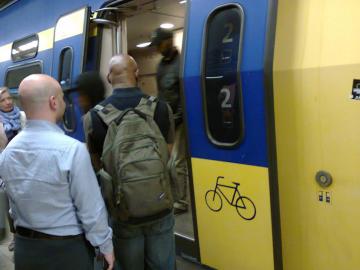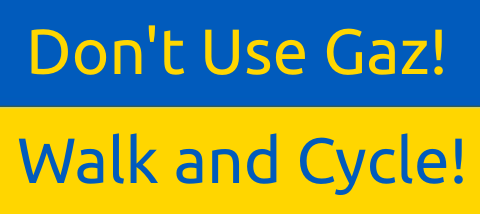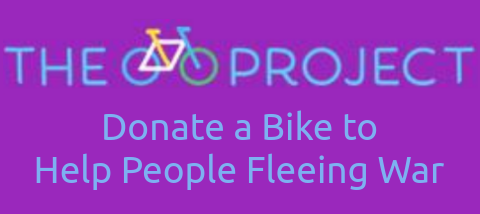
The Dutch have taken a holistic approach to infrastructure. The obvious signs of this will be apparent to anyone arriving by plane at Schiphol. The large, modern train station is directly below the airport, and since the trains are electric, unlike Birmingham New Street the environment is quiet and free of diesel fumes. On every other door of each train there will be a bicycle symbol, because it is expected that people will arrive at stations on a bike and may want to take that bike with them for their onward journey at the train's destination.
For those people not taking their bike with them there will be extensive cycle parking. Stations will have parking for thousands of bikes, typically under cover and staffed. There may be a repair and servicing facility, so that owners can have work done on their bike whilst they are making their train journey. And for those arriving without a bike, cycle hire is available. Indeed the Dutch railway company has its own hire scheme (OV-fiets). Hiring a bike is not expensive. When Push Bikes members visited the Netherlands in 2014, we hired bikes for €5 per day. The bikes only had a single speed (multi-speed bikes were available for a little more), but they had a sturdy rack and modern dynamo lights. These proved just fine for 200km of cycling.
 This integration extends to buses and trams. At stops there will be bike stands and even shelters for bikes. Cycling to the bus stop makes people more mobile when getting to the stop, so even buses can take direct routes. This is particularly important in the country, where having a bus visit every village and hamlet makes the bus slow and hopelessly uneconomical. However, even urban bus stops such as the one shown in the photo will have cycle parking. It may seem odd to cycle to an urban bus stop, given that buses are typically used for short journeys, but it must be remembered that not everyone is equally able-bodied. Providing cycle parking at bus stops is one of the ways in which disabled Dutch people are enabled.
This integration extends to buses and trams. At stops there will be bike stands and even shelters for bikes. Cycling to the bus stop makes people more mobile when getting to the stop, so even buses can take direct routes. This is particularly important in the country, where having a bus visit every village and hamlet makes the bus slow and hopelessly uneconomical. However, even urban bus stops such as the one shown in the photo will have cycle parking. It may seem odd to cycle to an urban bus stop, given that buses are typically used for short journeys, but it must be remembered that not everyone is equally able-bodied. Providing cycle parking at bus stops is one of the ways in which disabled Dutch people are enabled.
But these are just the obvious signs of the holistic approach to transport taken by the Dutch. What is not so obvious is the way incompatible forms of transport are kept apart.  Thus motor vehicles of all kinds are kept away from cycles and directed as quickly as possible on to routes optimised for those vehicles. Cycles in turn are provided with routes optimised for cycles. Since cycles have a lower maximum speed than motor vehicles, these routes are typically more direct than if the same journey were made by car. Also the need to stop at junctions will be minimised, not just because excessive stopping slows down cycle journeys to the point where they become unreasonably slow, but also because accelerating a bike takes much more physical effort than maintaining a steady speed. Critics assume this must make car journeys infuriatingly slow, but this is not the case. The Dutch road network is designed to get motor vehicles on to roads that allow safe high speed travel. Additionally, because of the high cycling modal share and the higher spatial efficiency of bikes compared with cars, congestion is reduced. And of course a Dutch driver will not find themselves stuck behind a cyclist on a road that should be fast. Driving in a country which has modern infrastructure design is in fact quicker and less frustrating than driving in Britain, with its outdated road network usage.
Thus motor vehicles of all kinds are kept away from cycles and directed as quickly as possible on to routes optimised for those vehicles. Cycles in turn are provided with routes optimised for cycles. Since cycles have a lower maximum speed than motor vehicles, these routes are typically more direct than if the same journey were made by car. Also the need to stop at junctions will be minimised, not just because excessive stopping slows down cycle journeys to the point where they become unreasonably slow, but also because accelerating a bike takes much more physical effort than maintaining a steady speed. Critics assume this must make car journeys infuriatingly slow, but this is not the case. The Dutch road network is designed to get motor vehicles on to roads that allow safe high speed travel. Additionally, because of the high cycling modal share and the higher spatial efficiency of bikes compared with cars, congestion is reduced. And of course a Dutch driver will not find themselves stuck behind a cyclist on a road that should be fast. Driving in a country which has modern infrastructure design is in fact quicker and less frustrating than driving in Britain, with its outdated road network usage.

This modal unravelling has an additional advantage. In Britain we try to fit two cycle lanes, two pavements, two running lanes, and parking all in two one street, and then discover the only way to make it fit with a margin between each is to make each lane hopelessly narrow. Alternatively we abandon the safety margin (such as on the Bristol Road south of Selly Oak) and find that hardly anyone wants to cycle. Unravelling the routes means that some roads don't need any cycling provision, whilst other roads (that would be rat runs in the UK) are the cycling provision. By closing some routes to through motor traffic, but keeping them open to cycle traffic, those roads become attractive for cycling with almost no constructional work. The work comes in at the planning level, because the network must be designed holistically over an area, not piecemeal. That is just good engineering.

The British approach is to try to keep every road open to through traffic on the assumption that it increases capacity. In fact this is not necessarily the case. Braess' paradox is named after the mathematician at Ruhr University in Germany, who, whilst working on traffic modelling, noticed the flow in a road network could be impeded by adding a new road. Additionally, it has been observed over many years that traffic levels go up as new roads are added. It might be assumed that the increasing traffic levels are driving the need to build new roads, but recently some councils have been temporarily closing roads and traffic lanes, and have found that this does not cause congestion. Some people will just deem their journey not worth the hassle, whilst others will switch to other modes of transport. Of course closing a road to motor traffic makes it attractive to cycle that journey. Thirdly, cycles are more spatially efficient than private cars, so they can carry more people in the same space. Thus replacing a road with a cycleway intrinsically increases capacity. Unfortunately in the UK we simply don't count cycle journeys, so we don't see that effect in our statistics. Ignoring some types of traffic in traffic models doesn't mean that that traffic doesn't exist, it's just inadequate engineering.
So the reason why cycling has such a high modal share in the Netherlands has nothing to do with hills, weather, having lots of space, genetic predisposition, or any of the other myths and excuses, it is simply because the Dutch have used modern, rigorous engineering techniques to ensure that multiple modes of travel are available, and all work co-operatively and as well as humanly possible. Cycling then becomes an attractive transport option to most of the population.


